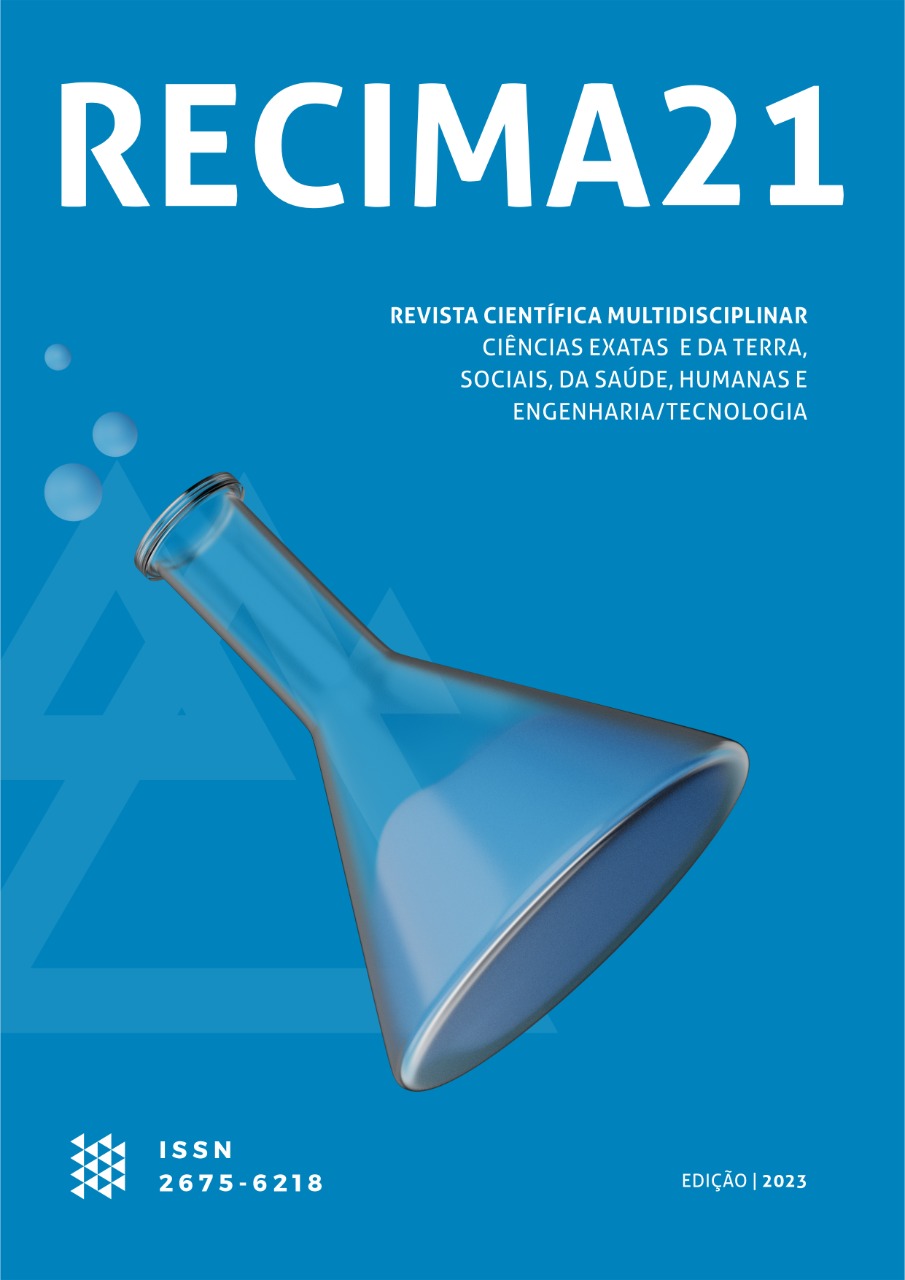PERCEPÇÃO ALIMENTAR E NUTRICIONAL NA PAROSMIA PÓS-COVID-19
DOI:
https://doi.org/10.47820/recima21.v4i7.3490Palavras-chave:
parosmia, covid-19, nutrição, qualidade de vidaResumo
A parosmia pós-COVID-19 é uma sequela da disfunção olfativa qualitativa que é a distorção no olfato e paladar. Por causa dessa disfunção, sentir cheiros desagradáveis e sabores estranhos passa a fazer parte do dia a dia de quem tem vivido com essa condição. Objetivo: O presente estudo discute as evidências científicas sobre a percepção olfatória e gustativa em indivíduos com parosmia pós-COVID-19. Metodologia: As pesquisas foram realizadas em março e abril de 2023, por artigos nas bases de dados da PubMed e Google Acadêmico, sendo selecionados dez artigos que compõe essa revisão de literatura. Resultado: A disfunção olfativa está entre os muitos sintomas da longa COVID-19, podendo ser quantitativa ou qualitativa. A parosmia é uma forma qualitativa comum de disfunção olfativa que tem sido correlacionada à infecção por COVID-19 e pode aparecer de forma tardia. A parosmia visa aparecer após uma lesão ou processo degenerativo que lesa os neurônios, levando a uma modificação na alimentação. Conclusão: O tempo de regeneração é individual por várias questões fisiológicas e o tratamento mais indicado é o treinamento olfativo que estimula os cheiros a retornarem as conexões certas. Entretanto, são necessários mais tratamentos específicos para a melhoria da qualidade de vida e auxílio na recuperação total do sentindo olfatório e no aporte nutricional.
Downloads
Referências
BURGES WATSON, Duika L. et al. Altered smell and taste: Anosmia, parosmia and the impact of long Covid-19. PLoS One, v. 16, n. 9, p. e0256998, 2021. Disponível em: <https://pubmed.ncbi.nlm.nih.gov/34559820/>
LERNER, David K. et al. Clinical features of parosmia associated with COVID‐19 infection. The Laryngoscope, v. 132, n. 3, p. 633-639, 2022. Disponível em: <https://pubmed.ncbi.nlm.nih.gov/34870334/>
WINTER, Anja L. et al. Impairment of quality of life due to COVID-19-induced long-term olfactory dysfunction. Frontiers in Psychology, v. 14, p. 1165911, 2023. Disponível em: <https://pubmed.ncbi.nlm.nih.gov/37151341/>
BOSCOLO-RIZZO, Paolo et al. COVID-19-related quantitative and qualitative olfactory and gustatory dysfunction: long-term prevalence and recovery rate. ORL, v. 85, n. 2, p. 67-71, 2023. Disponível em: <https://pubmed.ncbi.nlm.nih.gov/36063810/>
MONK, Aurelia S. et al. A longitudinal study of olfactory dysfunction and parosmia in mild COVID-19 cases. 2022. Disponível em: < https://pubmed.ncbi.nlm.nih.gov/37008801/>
ANDREA, Xolalpa-Peniche et al. Human Nasal Epithelium Damage as the Probable Mechanism Involved in the Development of Post-COVID-19 Parosmia. Indian Journal of Otolaryngology and Head & Neck Surgery, p. 1-7, 2023. Disponível em: <https://pubmed.ncbi.nlm.nih.gov/36817017/>
KELLY, Christine E. Parosmia and altered taste in patients recovering from Covid 19. Clinical Nutrition Open Science, v. 48, p. 1-10, 2023. Disponível em: < https://scholar.google.com.br/>
KHALIFAH, Wael et al. Persistent parosmia caused by COVID-19 infection: an emerging symptom. Cureus, v. 13, n. 11, 2021. Disponível em: <https://scholar.google.com.br/> 19+infection%3A+an+emerging+symptom&btnG=
KOPISHINSKAIA, Svetlana et al. Clinical features in russian patients with COVID-associated parosmia/phanthosmia. Psychiatria Danubina, v. 33, n. suppl 9, p. 130-136, 2021. Disponível em: <https://scholar.google.com.br/>
PARKER, Jane K. et al. Emerging pattern of post-COVID-19 parosmia and its effect on food perception. Foods, v. 11, n. 7, p. 967, 2022. Disponível em: <https://www.mdpi.com/2304-8158/11/7/967>
ESTEVÃO, Amélia. COVID-19. Acta Radiológica Portuguesa, v. 32, n. 1, p. 5-6, 2020. Disponível em: <https://revistas.rcaap.pt/actaradiologica/article/view/19800>
MAGALHÃES DOS SANTOS RIBEIRO, Sara. A relevância da nutrição para reabilitação do paladar e olfato em decorrência da COVID-19. 2021. Disponível em: <https://scholar.google.com.br>
COVID-19 Casos e Óbitos. [acessado em 30 de março de 2023]. Disponível em: https://infoms.saude.gov.br/extensions/covid-19_html/covid-19_html.
Histórico da pandemia de COVID-19 – OPAS/OMS. [acessado em 30 de março de 2023]. Disponível em: https://www.paho.org/pt/covid19/historico-da-pandemia-covid-19
RAVEENDRAN, A. V.; JAYADEVAN, Rajeev; SASHIDHARAN, S. Long COVID: an overview. Diabetes & Metabolic Syndrome: Clinical Research & Reviews, v. 15, n. 3, p. 869-875, 2021. Disponível em: <https://pubmed.ncbi.nlm.nih.gov/33892403/>
ÖZCEYLAN, Gökmen; ALTUNTAŞ, Sibel Baktır. Relationship between initial symptoms and prognosis of patients with Covid-19. Atención Primaria, v. 54, n. 1, p. 102146, 2022. Disponível em: <https://pubmed.ncbi.nlm.nih.gov/34757290/>
Downloads
Publicado
Licença
Copyright (c) 2023 RECIMA21 - Revista Científica Multidisciplinar - ISSN 2675-6218

Este trabalho está licenciado sob uma licença Creative Commons Attribution 4.0 International License.
Os direitos autorais dos artigos/resenhas/TCCs publicados pertecem à revista RECIMA21, e seguem o padrão Creative Commons (CC BY 4.0), permitindo a cópia ou reprodução, desde que cite a fonte e respeite os direitos dos autores e contenham menção aos mesmos nos créditos. Toda e qualquer obra publicada na revista, seu conteúdo é de responsabilidade dos autores, cabendo a RECIMA21 apenas ser o veículo de divulgação, seguindo os padrões nacionais e internacionais de publicação.













